check engine light Alfa Romeo 4C 2015 Owner handbook (in English)
[x] Cancel search | Manufacturer: ALFA ROMEO, Model Year: 2015, Model line: 4C, Model: Alfa Romeo 4C 2015Pages: 199, PDF Size: 7.67 MB
Page 6 of 199
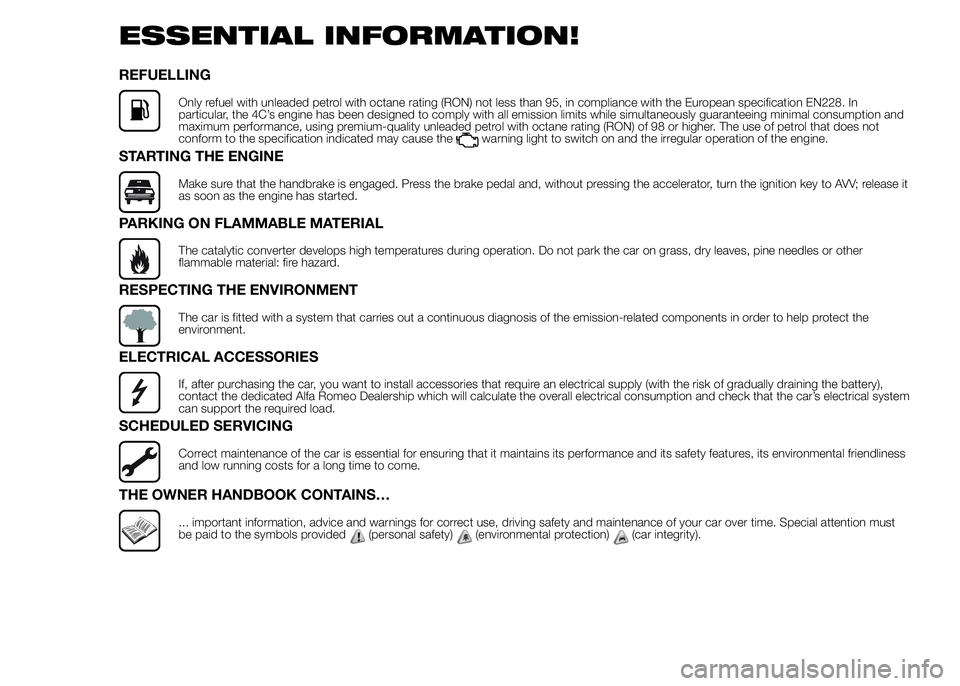
ESSENTIAL INFORMATION!
REFUELLING
Only refuel with unleaded petrol with octane rating (RON) not less than 95, in compliance with the European specification EN228. In
particular, the 4C’s engine has been designed to comply with all emission limits while simultaneously guaranteeing minimal consumption and
maximum performance, using premium-quality unleaded petrol with octane rating (RON) of 98 or higher. The use of petrol that does not
conform to the specification indicated may cause the
warning light to switch on and the irregular operation of the engine.
STARTING THE ENGINE
Make sure that the handbrake is engaged. Press the brake pedal and, without pressing the accelerator, turn the ignition key to AVV; release it
as soon as the engine has started.
PARKING ON FLAMMABLE MATERIAL
The catalytic converter develops high temperatures during operation. Do not park the car on grass, dry leaves, pine needles or other
flammable material: fire hazard.
RESPECTING THE ENVIRONMENT
The car is fitted with a system that carries out a continuous diagnosis of the emission-related components in order to help protect the
environment.
ELECTRICAL ACCESSORIES
If, after purchasing the car, you want to install accessories that require an electrical supply (with the risk of gradually draining the battery),
contact the dedicated Alfa Romeo Dealership which will calculate the overall electrical consumption and check that the car’s electrical system
can support the required load.
SCHEDULED SERVICING
Correct maintenance of the car is essential for ensuring that it maintains its performance and its safety features, its environmental friendliness
and low running costs for a long time to come.
THE OWNER HANDBOOK CONTAINS…
... important information, advice and warnings for correct use, driving safety and maintenance of your car over time. Special attention must
be paid to the symbols provided(personal safety)(environmental protection)(car integrity).
Page 10 of 199
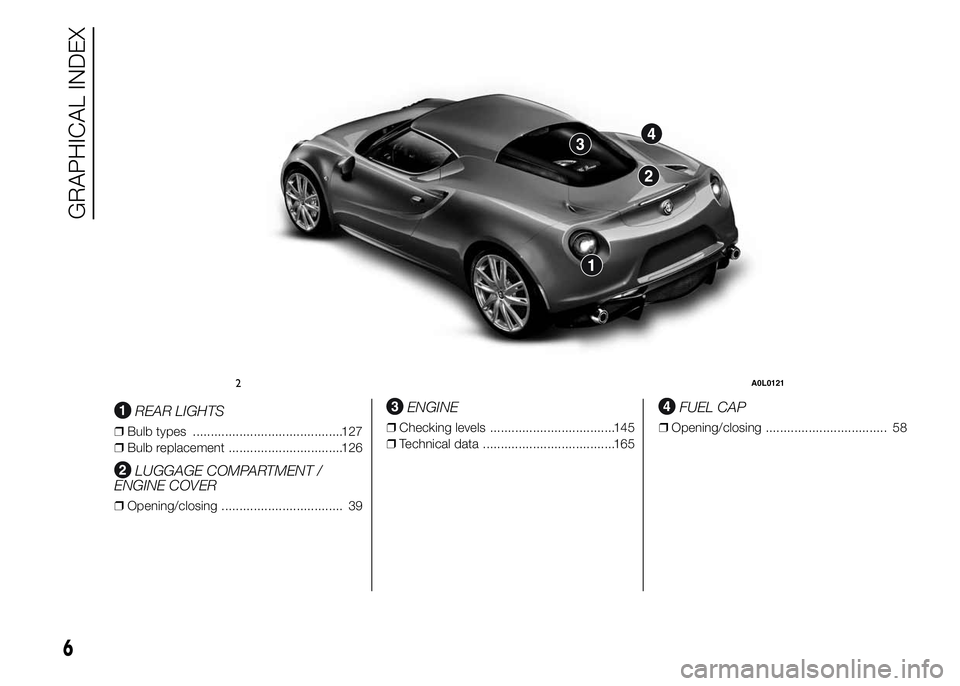
.
REAR LIGHTS
❒Bulb types ..........................................127
❒Bulb replacement ................................126
LUGGAGE COMPARTMENT /
ENGINE COVER
❒Opening/closing .................................. 39
ENGINE
❒Checking levels ...................................145
❒Technical data .....................................165
FUEL CAP
❒Opening/closing .................................. 58
2A0L0121
6
GRAPHICAL INDEX
Page 37 of 199
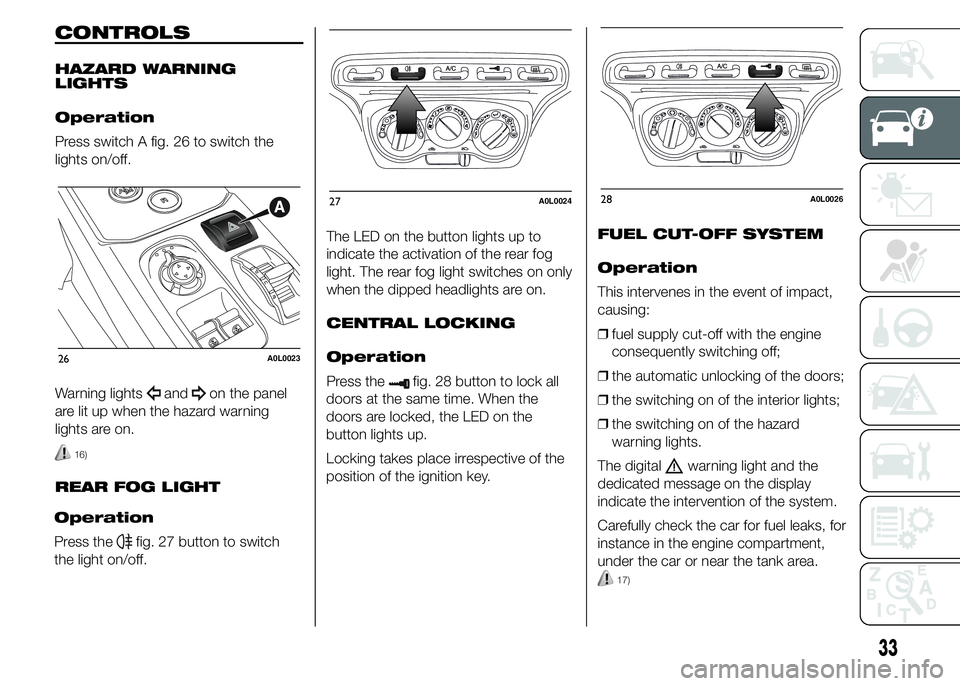
CONTROLS
HAZARD WARNING
LIGHTS
Operation
Press switch A fig. 26 to switch the
lights on/off.
Warning lights
andon the panel
are lit up when the hazard warning
lights are on.
16)
REAR FOG LIGHT
Operation
Press the
fig. 27 button to switch
the light on/off.The LED on the button lights up to
indicate the activation of the rear fog
light. The rear fog light switches on only
when the dipped headlights are on.
CENTRAL LOCKING
Operation
Press the
fig. 28 button to lock all
doors at the same time. When the
doors are locked, the LED on the
button lights up.
Locking takes place irrespective of the
position of the ignition key.FUEL CUT-OFF SYSTEM
Operation
This intervenes in the event of impact,
causing:
❒fuel supply cut-off with the engine
consequently switching off;
❒the automatic unlocking of the doors;
❒the switching on of the interior lights;
❒the switching on of the hazard
warning lights.
The digital
warning light and the
dedicated message on the display
indicate the intervention of the system.
Carefully check the car for fuel leaks, for
instance in the engine compartment,
under the car or near the tank area.
17)
26A0L0023
27A0L002428A0L0026
33
Page 81 of 199
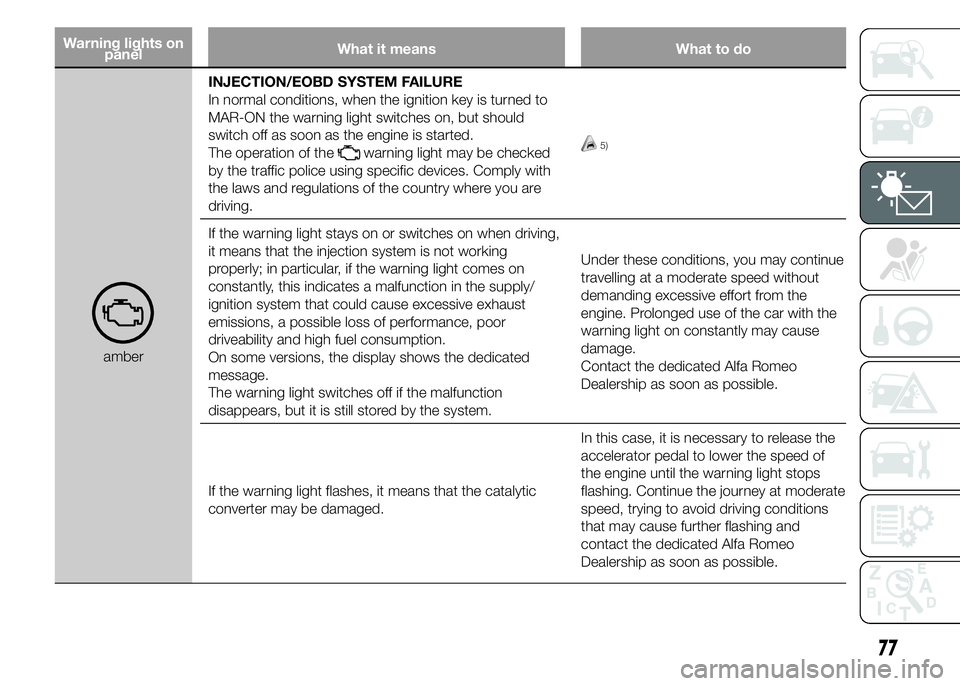
Warning lights on
panelWhat it means What to do
amberINJECTION/EOBD SYSTEM FAILURE
In normal conditions, when the ignition key is turned to
MAR-ON the warning light switches on, but should
switch off as soon as the engine is started.
The operation of the
warning light may be checked
by the traffic police using specific devices. Comply with
the laws and regulations of the country where you are
driving.5)
If the warning light stays on or switches on when driving,
it means that the injection system is not working
properly; in particular, if the warning light comes on
constantly, this indicates a malfunction in the supply/
ignition system that could cause excessive exhaust
emissions, a possible loss of performance, poor
driveability and high fuel consumption.
On some versions, the display shows the dedicated
message.
The warning light switches off if the malfunction
disappears, but it is still stored by the system.Under these conditions, you may continue
travelling at a moderate speed without
demanding excessive effort from the
engine. Prolonged use of the car with the
warning light on constantly may cause
damage.
Contact the dedicated Alfa Romeo
Dealership as soon as possible.
If the warning light flashes, it means that the catalytic
converter may be damaged.In this case, it is necessary to release the
accelerator pedal to lower the speed of
the engine until the warning light stops
flashing. Continue the journey at moderate
speed, trying to avoid driving conditions
that may cause further flashing and
contact the dedicated Alfa Romeo
Dealership as soon as possible.
77
Page 87 of 199
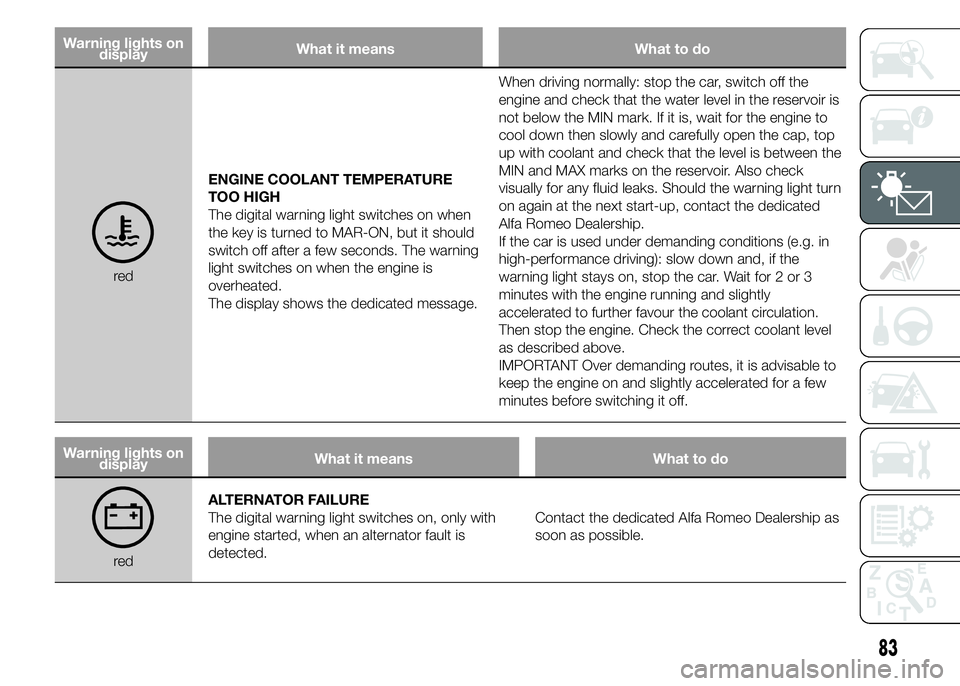
Warning lights on
displayWhat it means What to do
redENGINE COOLANT TEMPERATURE
TOO HIGH
The digital warning light switches on when
the key is turned to MAR-ON, but it should
switch off after a few seconds. The warning
light switches on when the engine is
overheated.
The display shows the dedicated message.When driving normally: stop the car, switch off the
engine and check that the water level in the reservoir is
not below the MIN mark. If it is, wait for the engine to
cool down then slowly and carefully open the cap, top
up with coolant and check that the level is between the
MIN and MAX marks on the reservoir. Also check
visually for any fluid leaks. Should the warning light turn
on again at the next start-up, contact the dedicated
Alfa Romeo Dealership.
If the car is used under demanding conditions (e.g. in
high-performance driving): slow down and, if the
warning light stays on, stop the car. Wait for 2 or 3
minutes with the engine running and slightly
accelerated to further favour the coolant circulation.
Then stop the engine. Check the correct coolant level
as described above.
IMPORTANT Over demanding routes, it is advisable to
keep the engine on and slightly accelerated for a few
minutes before switching it off.
Warning lights on
displayWhat it means What to do
redALTERNATOR FAILURE
The digital warning light switches on, only with
engine started, when an alternator fault is
detected.Contact the dedicated Alfa Romeo Dealership as
soon as possible.
83
Page 118 of 199
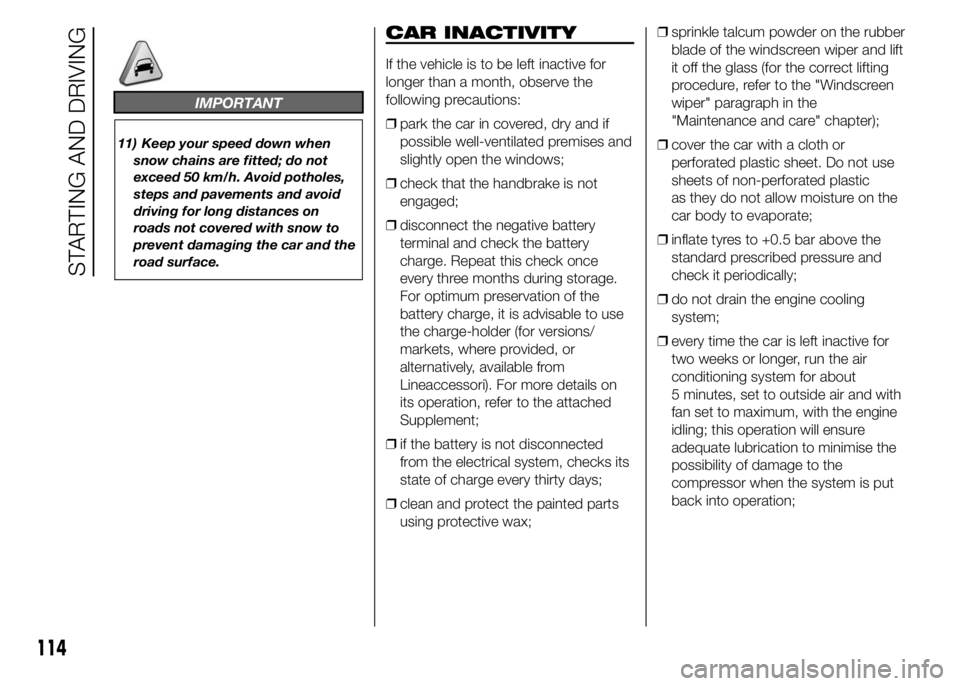
IMPORTANT
11) Keep your speed down when
snow chains are fitted; do not
exceed 50 km/h. Avoid potholes,
steps and pavements and avoid
driving for long distances on
roads not covered with snow to
prevent damaging the car and the
road surface.
CAR INACTIVITY
If the vehicle is to be left inactive for
longer than a month, observe the
following precautions:
❒park the car in covered, dry and if
possible well-ventilated premises and
slightly open the windows;
❒check that the handbrake is not
engaged;
❒disconnect the negative battery
terminal and check the battery
charge. Repeat this check once
every three months during storage.
For optimum preservation of the
battery charge, it is advisable to use
the charge-holder (for versions/
markets, where provided, or
alternatively, available from
Lineaccessori). For more details on
its operation, refer to the attached
Supplement;
❒if the battery is not disconnected
from the electrical system, checks its
state of charge every thirty days;
❒clean and protect the painted parts
using protective wax;❒sprinkle talcum powder on the rubber
blade of the windscreen wiper and lift
it off the glass (for the correct lifting
procedure, refer to the "Windscreen
wiper" paragraph in the
"Maintenance and care" chapter);
❒cover the car with a cloth or
perforated plastic sheet. Do not use
sheets of non-perforated plastic
as they do not allow moisture on the
car body to evaporate;
❒inflate tyres to +0.5 bar above the
standard prescribed pressure and
check it periodically;
❒do not drain the engine cooling
system;
❒every time the car is left inactive for
two weeks or longer, run the air
conditioning system for about
5 minutes, set to outside air and with
fan set to maximum, with the engine
idling; this operation will ensure
adequate lubrication to minimise the
possibility of damage to the
compressor when the system is put
back into operation;
114
STARTING AND DRIVING
Page 122 of 199
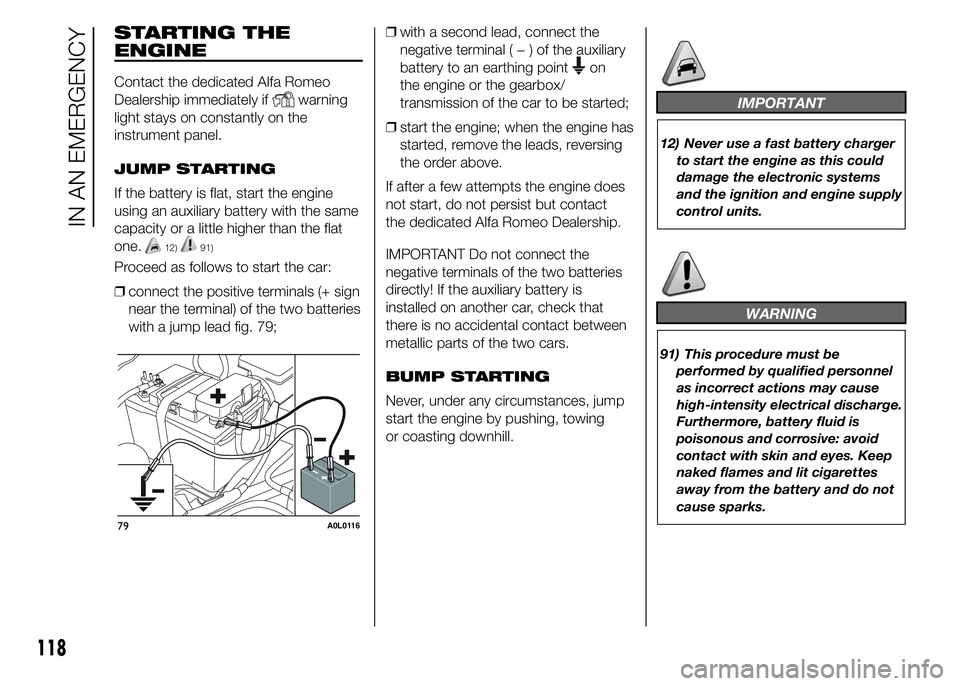
STARTING THE
ENGINE
Contact the dedicated Alfa Romeo
Dealership immediately if
warning
light stays on constantly on the
instrument panel.
JUMP STARTING
If the battery is flat, start the engine
using an auxiliary battery with the same
capacity or a little higher than the flat
one.
12)91)
Proceed as follows to start the car:
❒connect the positive terminals (+ sign
near the terminal) of the two batteries
with a jump lead fig. 79;❒with a second lead, connect the
negative terminal(−)oftheauxiliary
battery to an earthing point
on
the engine or the gearbox/
transmission of the car to be started;
❒start the engine; when the engine has
started, remove the leads, reversing
the order above.
If after a few attempts the engine does
not start, do not persist but contact
the dedicated Alfa Romeo Dealership.
IMPORTANT Do not connect the
negative terminals of the two batteries
directly! If the auxiliary battery is
installed on another car, check that
there is no accidental contact between
metallic parts of the two cars.
BUMP STARTING
Never, under any circumstances, jump
start the engine by pushing, towing
or coasting downhill.
IMPORTANT
12) Never use a fast battery charger
to start the engine as this could
damage the electronic systems
and the ignition and engine supply
control units.
WARNING
91) This procedure must be
performed by qualified personnel
as incorrect actions may cause
high-intensity electrical discharge.
Furthermore, battery fluid is
poisonous and corrosive: avoid
contact with skin and eyes. Keep
naked flames and lit cigarettes
away from the battery and do not
cause sparks.
79A0L0116
118
IN AN EMERGENCY
Page 123 of 199

REPAIRING A WHEEL
GENERAL
INSTRUCTIONS
The car is equipped with a quick tyre
repair device called the "Fix&Go
automatic" kit.
92) 94)
To use it, follow the instructions below.
93) 95) 96)13)2)
"Fix&Go automatic" KIT
It is located in the luggage
compartment.
The kit includes:
❒bottle A fig. 80 containing sealant
and fitted with: filling tube B and
adhesive label C with the wording
“max. 80 km/h” to be placed in
a clearly visible position (e.g. on the
dashboard) after repairing the tyre;
❒compressor D complete with
pressure gauge and connectors;
❒an information leaflet fig. 81,
providing instructions for using the kit
correctly. This booklet should be
given to the persons charged with
handling the tyre treated with this kit;
❒a pair of gloves located in the side
compartment of the compressor;
❒adaptors for inflating different
elements.IMPORTANT The sealant is suitable for
use at temperatures in the range from
−20°C to +50°C. The sealant has an
expiry date.INFLATION PROCEDURE
Proceed as follows:
97)
❒engage the handbrake, unscrew the
tyre valve cap, take out filler hose A
fig. 82 and tighten ring nut B on
the tyre valve;
❒make sure that switch A fig. 83 for
the compressor is in position 0 (off),
start the engine, insert the plug
into the cigar lighter socket on the
central tunnel (see fig. 84) and switch
on the compressor by bringing
switch A fig. 83 to I (on);
❒inflate the tyre to the pressure
indicated in the “Wheels” paragraph
in the “Technical data” chapter. In
order to obtain a more precise
reading, check the pressure value on
pressure gauge B fig. 83 with the
compressor off;
80A0L0076
81A0L0077
82A0L0078
119
Page 148 of 199
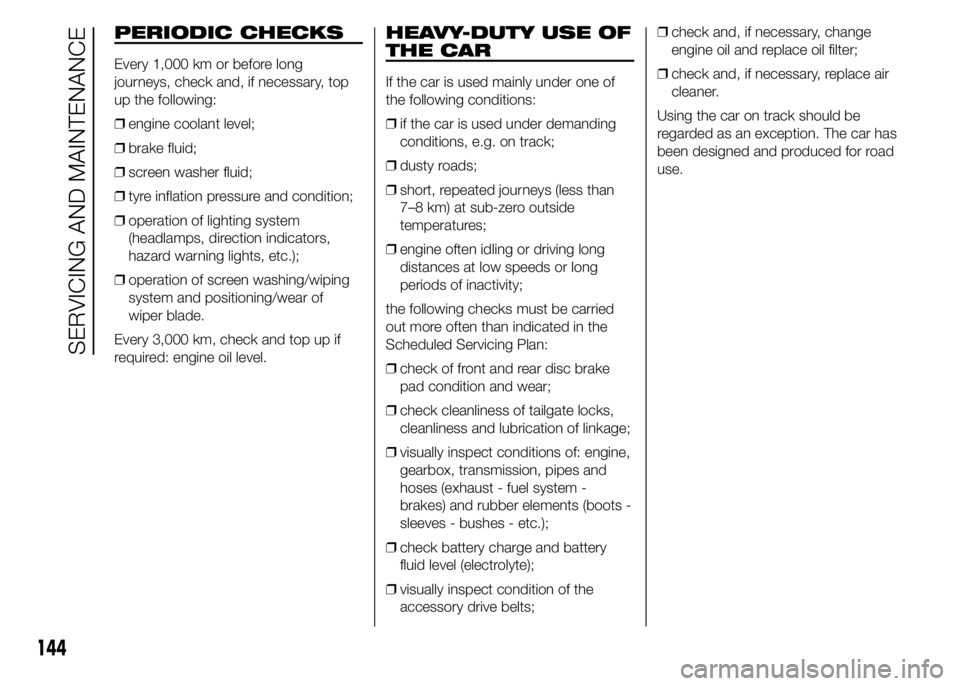
PERIODIC CHECKS
Every 1,000 km or before long
journeys, check and, if necessary, top
up the following:
❒engine coolant level;
❒brake fluid;
❒screen washer fluid;
❒tyre inflation pressure and condition;
❒operation of lighting system
(headlamps, direction indicators,
hazard warning lights, etc.);
❒operation of screen washing/wiping
system and positioning/wear of
wiper blade.
Every 3,000 km, check and top up if
required: engine oil level.
HEAVY-DUTY USE OF
THE CAR
If the car is used mainly under one of
the following conditions:
❒if the car is used under demanding
conditions, e.g. on track;
❒dusty roads;
❒short, repeated journeys (less than
7–8 km) at sub-zero outside
temperatures;
❒engine often idling or driving long
distances at low speeds or long
periods of inactivity;
the following checks must be carried
out more often than indicated in the
Scheduled Servicing Plan:
❒check of front and rear disc brake
pad condition and wear;
❒check cleanliness of tailgate locks,
cleanliness and lubrication of linkage;
❒visually inspect conditions of: engine,
gearbox, transmission, pipes and
hoses (exhaust - fuel system -
brakes) and rubber elements (boots -
sleeves - bushes - etc.);
❒check battery charge and battery
fluid level (electrolyte);
❒visually inspect condition of the
accessory drive belts;❒check and, if necessary, change
engine oil and replace oil filter;
❒check and, if necessary, replace air
cleaner.
Using the car on track should be
regarded as an exception. The car has
been designed and produced for road
use.
144
SERVICING AND MAINTENANCE
Page 155 of 199
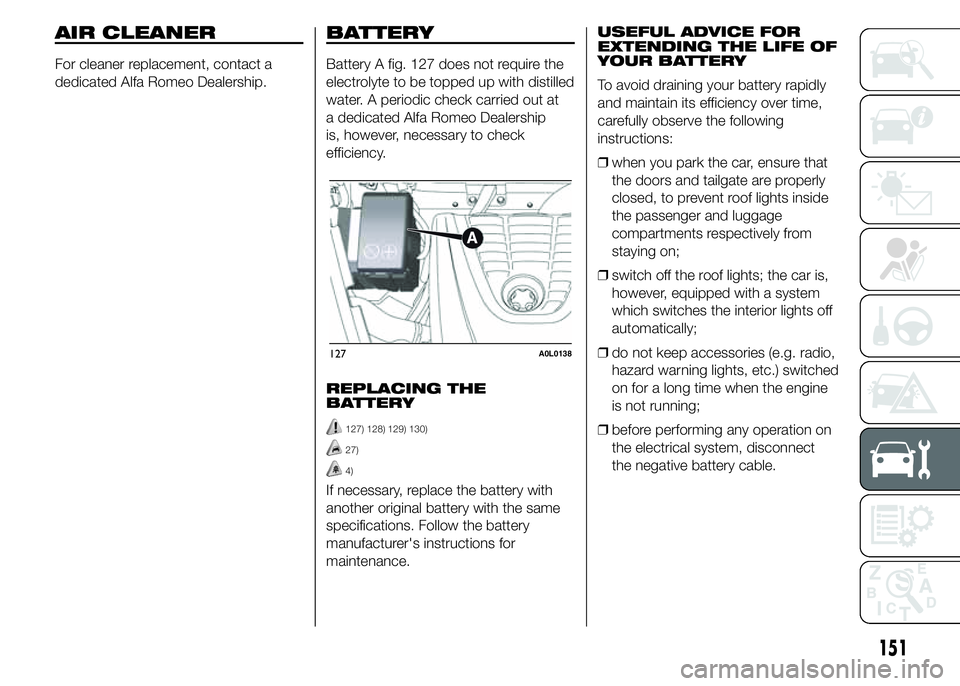
AIR CLEANER
For cleaner replacement, contact a
dedicated Alfa Romeo Dealership.
BATTERY
Battery A fig. 127 does not require the
electrolyte to be topped up with distilled
water. A periodic check carried out at
a dedicated Alfa Romeo Dealership
is, however, necessary to check
efficiency.
REPLACING THE
BATTERY
127) 128) 129) 130)
27)
4)
If necessary, replace the battery with
another original battery with the same
specifications. Follow the battery
manufacturer's instructions for
maintenance.USEFUL ADVICE FOR
EXTENDING THE LIFE OF
YOUR BATTERY
To avoid draining your battery rapidly
and maintain its efficiency over time,
carefully observe the following
instructions:
❒when you park the car, ensure that
the doors and tailgate are properly
closed, to prevent roof lights inside
the passenger and luggage
compartments respectively from
staying on;
❒switch off the roof lights; the car is,
however, equipped with a system
which switches the interior lights off
automatically;
❒do not keep accessories (e.g. radio,
hazard warning lights, etc.) switched
on for a long time when the engine
is not running;
❒before performing any operation on
the electrical system, disconnect
the negative battery cable.
127A0L0138
151